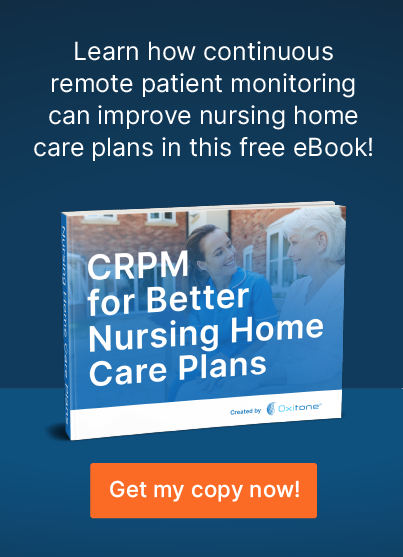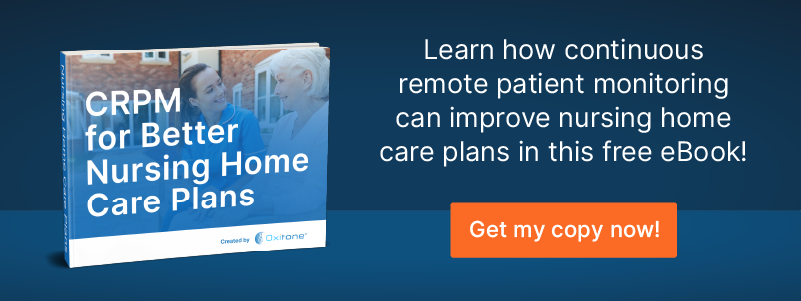Recovering from COVID-19 takes more than treating patients in the ER or hospital. Even once patients have recovered enough that it’s safe to return home, post-COVID symptom management remains important. Even those afflicted with COVID who did not require hospitalization may still need tracking and monitoring afterward.
According to the Centers for Disease Control, approximately 10% of people experience prolonged illness after COVID-19, and as many as a third of patients who were not hospitalized have lagging symptoms.
In fact, 80% suffer COVID symptoms post recovery two months after being hospitalized. Among the most serious concerns are patients who had pre-existing conditions before contracting COVID, such as those living with chronic illnesses.
Home pulse oximetry can be helpful in monitoring conditions and tracking COVID symptoms post recovery. Continuous remote patient monitoring (CRPM) helps physicians and healthcare providers monitor patients’ vital signs, including respiratory rate, temperature, blood oxygen levels, pulse rate, and heart rate variability.
Pre-pandemic, remote monitoring devices were primarily used to manage chronic conditions, such as diabetes or COPD. This helped patients manage chronic conditions at home and prevent unnecessary hospital visits. Remote monitoring is now increasingly being used to track COVID-19 symptoms and conditions both during and after the period of illness. Monitoring devices are also effective at preventing readmissions.
The Benefits of CRPM in Tracking COVID Symptoms Post Recovery
Using remote monitoring provides several benefits when tracking COVID symptoms post recovery. One of the biggest benefits is real-time monitoring while patients are at home.
In-house care for post-COVID treatment has been shown to be safer. It also provides a more cost-efficient treatment compared to hospitalization or extended-care facilities.
Using remote monitoring, healthcare providers can continue tracking conditions and symptoms. This reduces physician workload and office visits. Patients also have the peace of mind that they are being monitored even in the comfort of their homes.
Remote monitoring significantly increases patient compliance levels. A pre-COVID study done by Trinity Health showed a 90% compliance rate and a patient satisfaction score consistently exceeding 90%. Notably, there was also a reduction in readmissions by nearly 50%.
Wearable medical devices, such as Oxitone’s wrist sensor pulse oximeter, continuously monitor vital signs, such as heart rate and oxygen saturation levels. In treating patients for COVID symptoms post recovery, CRPM provides a better alternative to most RPM kits.
Some hospitals use RPM kits that require patients to monitor conditions by manually using different devices. Patients have to enter their symptoms, temps, and oxygen levels into a specific platform. While this kind of information is needed, RPM kits have built-in limitations. First, they rely on patient compliance and accurate reporting, neither of which can be assured. Patients are also not monitored continuously, which can mean sudden spikes or anomalies may not be noticed until self-measured.
CRPM with an Oxitone medical wearable eliminates the need to use multiple devices or rely on patients accurately recording information. It is the world’s first FDA-cleared wrist-sensor pulse oximetry monitor and can be used effectively to monitor vital signs for post-COVID care.
The Wearable Pulse Oximeter for Tracking COVID Symptoms Post Recovery
The pulse oximeter by Oxitone monitors the health data that doctors and patients need to monitor health conditions, including:
- Respiratory rate
- Skin temperature
- Motion/activity
- Sleep patterns
- Blood oxygen (SpO2)
- Pulse rate and HRV
By better monitoring COVID symptoms post recovery, health professionals can track conditions that may lead to exacerbations and flag potential warning signs before they become serious.
Using AI and predictive analytics, warning signs can be spotted much earlier. One study done by the University of Pennsylvania showed that predictive analysis tools using artificial intelligence and machine learning could identify patients suffering from complications as much as twelve hours earlier in some cases.
CRPM also significantly increases patient compliance. Patients do not need to remember to use devices or record conditions accurately. A wearable medical device, like the Oxitone wrist pulse oximeter, records health data automatically and in real time and generates notifications when attention is needed. The Oxitone 1000M implements five levels of verification to initiate alerts to prevent disturbing patients with false notifications.
Precise, Accurate Data for Monitoring and Treating Patients
All of this provides physicians access to the precise data that they need to accurately monitor and treat post-COVID symptoms, while reducing over-reliance on direct care except when necessary.
Remote patient monitoring companies and physicians are improving the management and care of patients with COVID symptoms post recovery by using the Oxitone wearable pulse oximeter.
Here at Oxitone, we boost value-based healthcare by delivering extraordinary patient, clinical, and economical outcomes at reduced medical utilization and cost. Patients need a prompt response to emergencies. Physicians need an easy and timely follow-up with patients. Our mission is to transform chronic disease management and help save lives worldwide.
Let’s save lives together! To see how we help remote patient monitoring companies and physicians improve the management and care of high-risk patients, contact us today!


